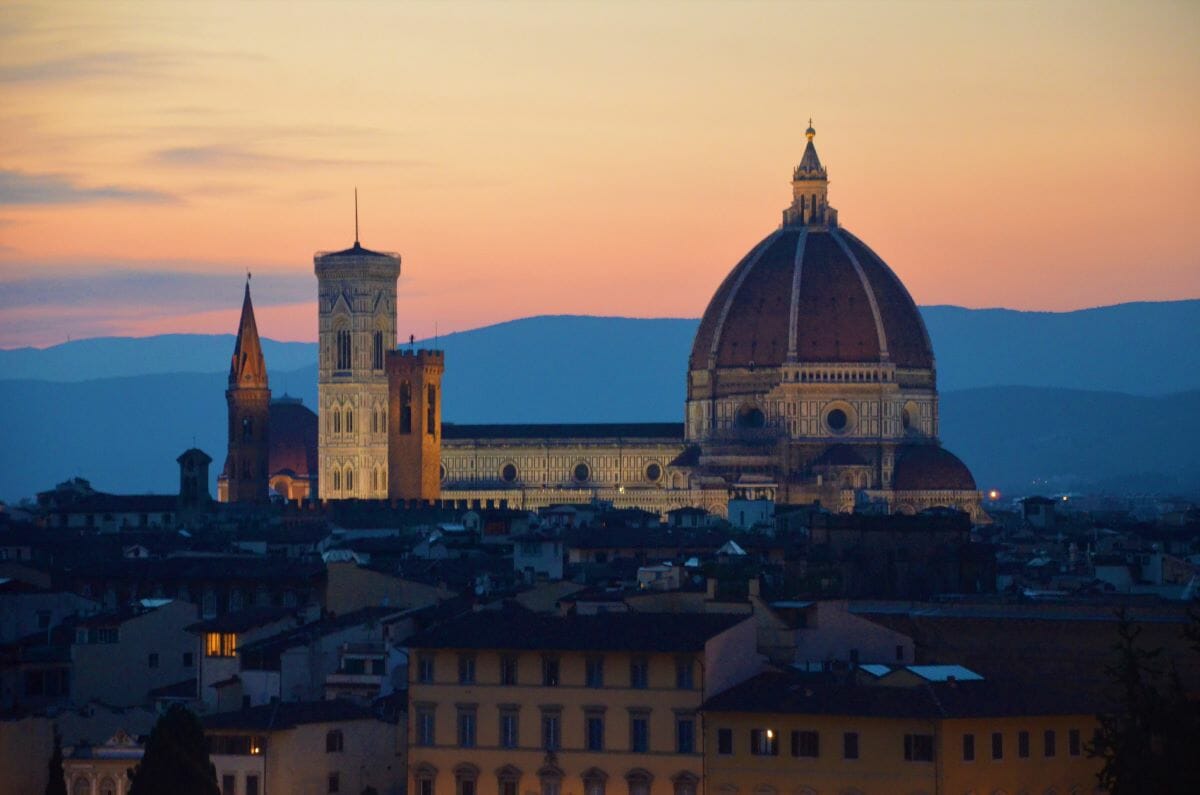
The Florence Duomo Unveiled: 7 Fascinating Historical Facts
May 15, 2025
Florence is home to some of Italy’s finest Renaissance art, history and architecture. It’s a must-see for visitors to Italy and one of the world’s most famous cultural cities. But rising above all these masterpieces, both literally and some would argue figuratively, is the colossal Florence Duomo, or otherwise known as Santa Maria Del Fiore.
The enormous red-tiled dome—the biggest brick and mortar dome in the world—is both a product and a symbol of the incredibly fecund creative culture that has defined the city for over 500 years.
Read along to learn about seven things you probably didn’t know about the Florence Duomo.
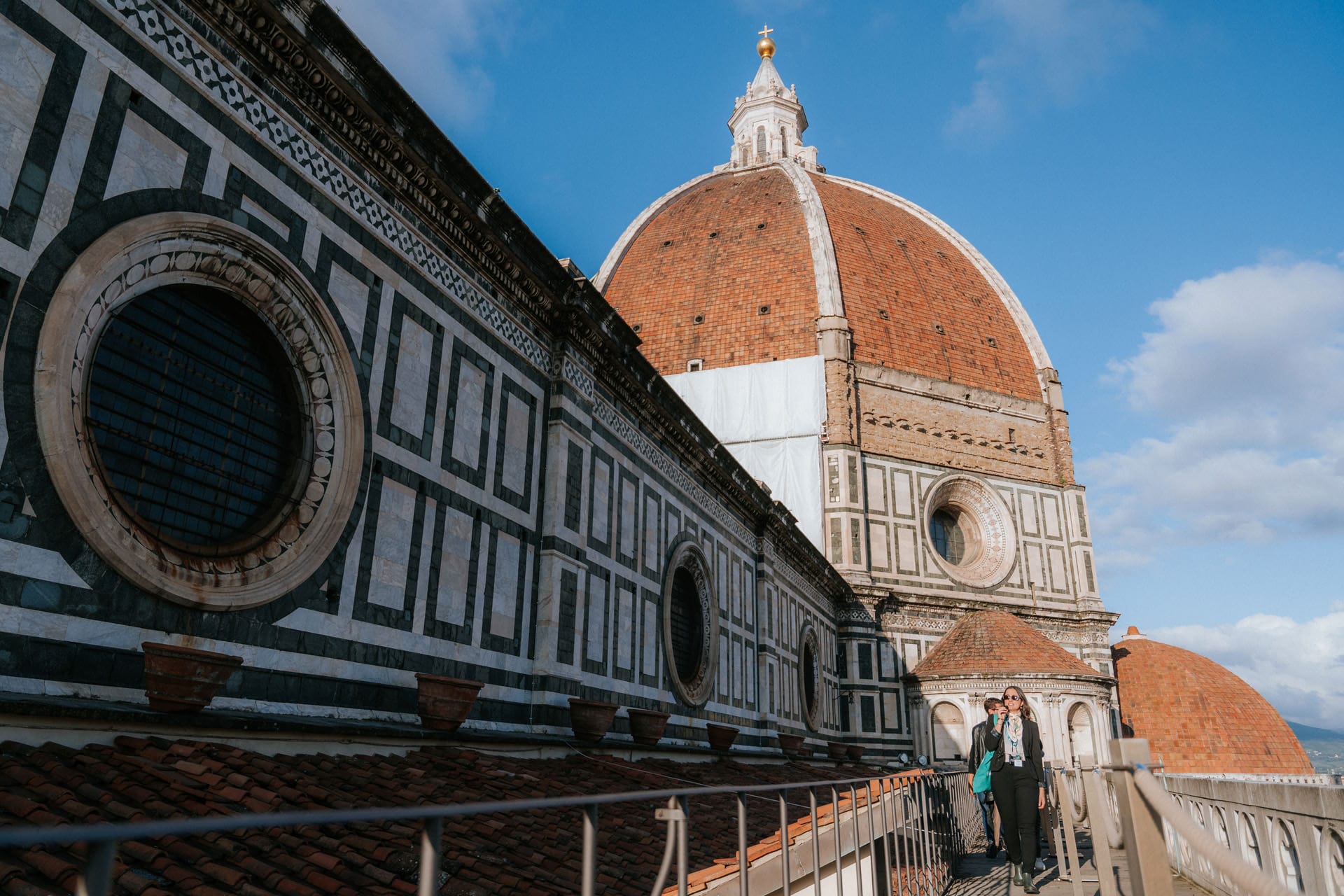
The Florence Historic Centre has been designated as a UNESCO World Heritage Site since 1982.
Table of Contents
ToggleA brief history of the Florence Duomo
Florence started building its grand cathedral in the 13th century, well before the Renaissance. However, about a century later, when it was almost finished, the builders faced a major issue: a nearly 150-foot oval hole in the roof where the Florence Duomo was supposed to be.
The problem was that not just any dome could do the job. In order to cover the hole it would need to be the biggest dome built since…well, ever. Not only had a dome of that diameter never been built, no one was exactly sure that it could be built, much less how to go about it.
Had it not been for the persistence of a brilliant mind named Filippo Brunelleschi, the iconic dome atop the Florence Cathedral might never have graced the city’s skyline.
Today, the Florence Duomo (“Il Duomo” in Italian), also known as the dome of Santa Maria del Fiore, is so iconic that many recognize the Cathedral primarily for its dome. The significance of the church is further underscored by the fact that, despite its official name, it is frequently referred to by a name that distinctly emphasizes the prominence of its iconic dome.
Without further ado, let’s delve into some fascinating facts about one of Florence’s and Italy’s most iconic landmarks.
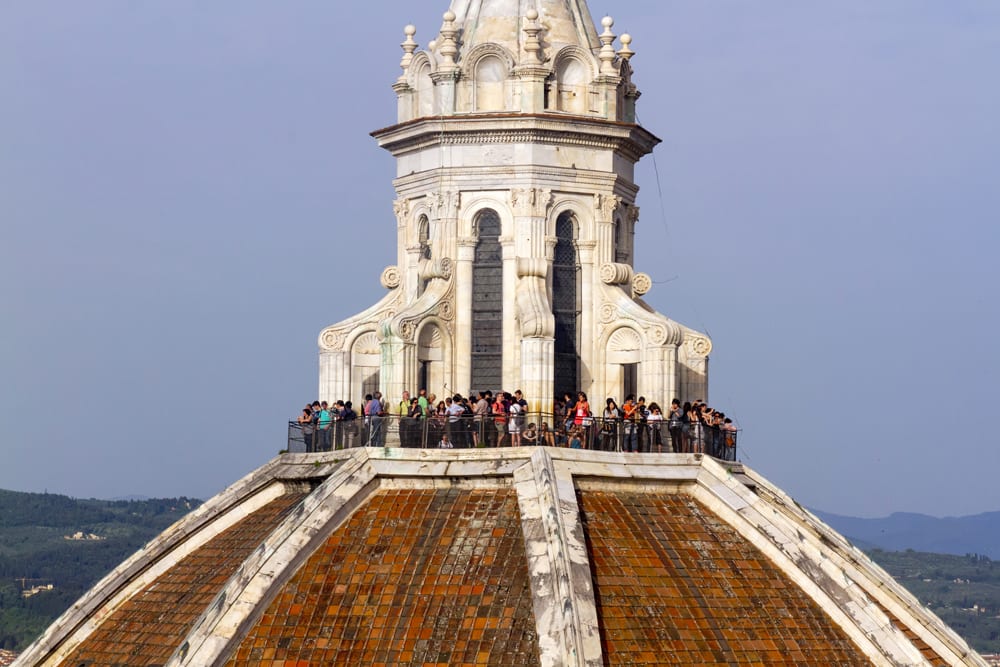
If you have no fear of heights, consider heading to the top of the Florence Duomo.
The Florence Duomo is a major achievement in Renaissance architecture
A dome of the size and shape of the Florence Duomo that could support itself without collapsing was thought completely impossible to build before the Renaissance. Though similar structures, like The Pantheon, had been constructed before, the knowledge of how they had been built had been completely lost during the long, dark Middle Ages.
Brunelleschi devised an astonishingly intricate design involving two domes, stacked atop each other, employing a unique herringbone brick pattern. He also incorporated an internal chain system encircling the outer dome, similar to the metal rings on a barrel, to effectively distribute the weight.
Prior to Brunelleschi’s innovation, the only known method for constructing such a dome involved the use of flying buttresses. However, the Florentines staunchly opposed this approach, as their archrivals in the northern city of Milan had employed it for their own dome.
Today, the massive dome is still one of the largest in the entire world. It’s even larger than St. Peter’s dome in the Vatican City!
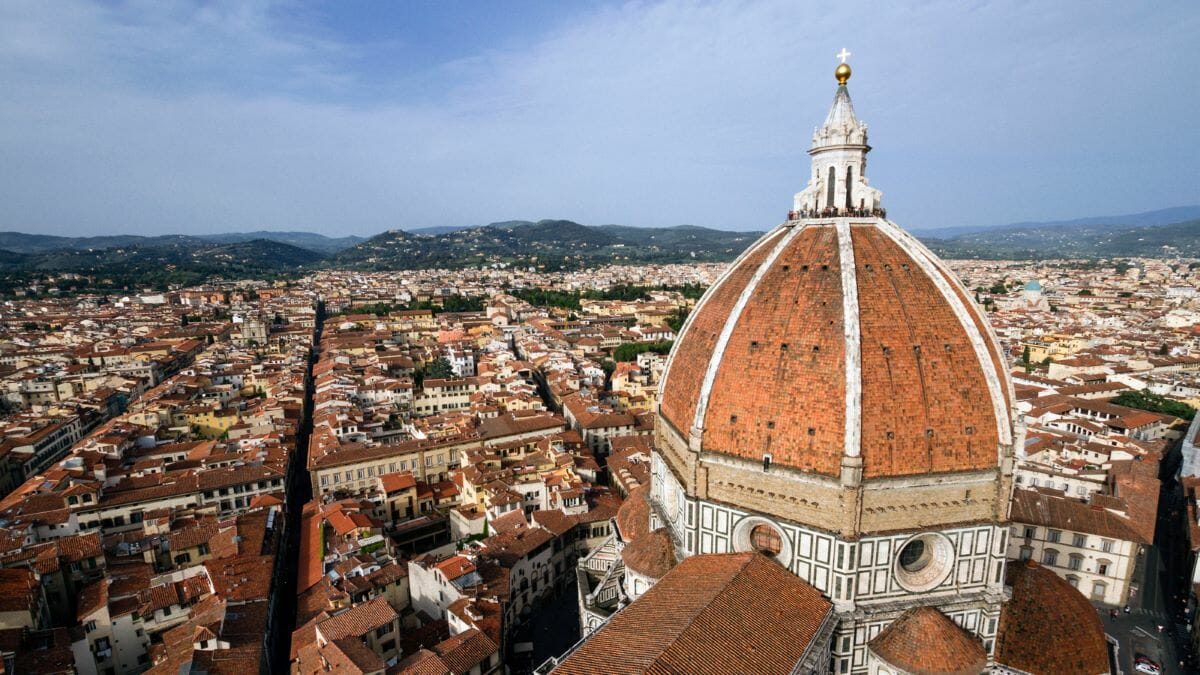
The Florence Duomo provides some of the city’s best views.
Before the Florence Duomo, Brunelleschi trained as a goldsmith
Brunelleschi, who initially trained as a goldsmith in Florence, quickly gained an impressive reputation. During his apprenticeship, he honed various skills beyond metalwork, including drawing, painting, and carving. He delved into the mechanics of wheels, gears, and weights, even constructing clocks and mastering linear perspective. Alongside his close friend Donatello, he embarked on a pilgrimage to Rome.
There, he studied the city’s ancient monuments, uncovering architectural secrets from the Roman Empire that had long been forgotten. Evolving from a prodigious talent into a true Renaissance polymath, Brunelleschi’s diverse interests converged to shape his groundbreaking design for the Florence Duomo, where gold took a backseat to innovation.
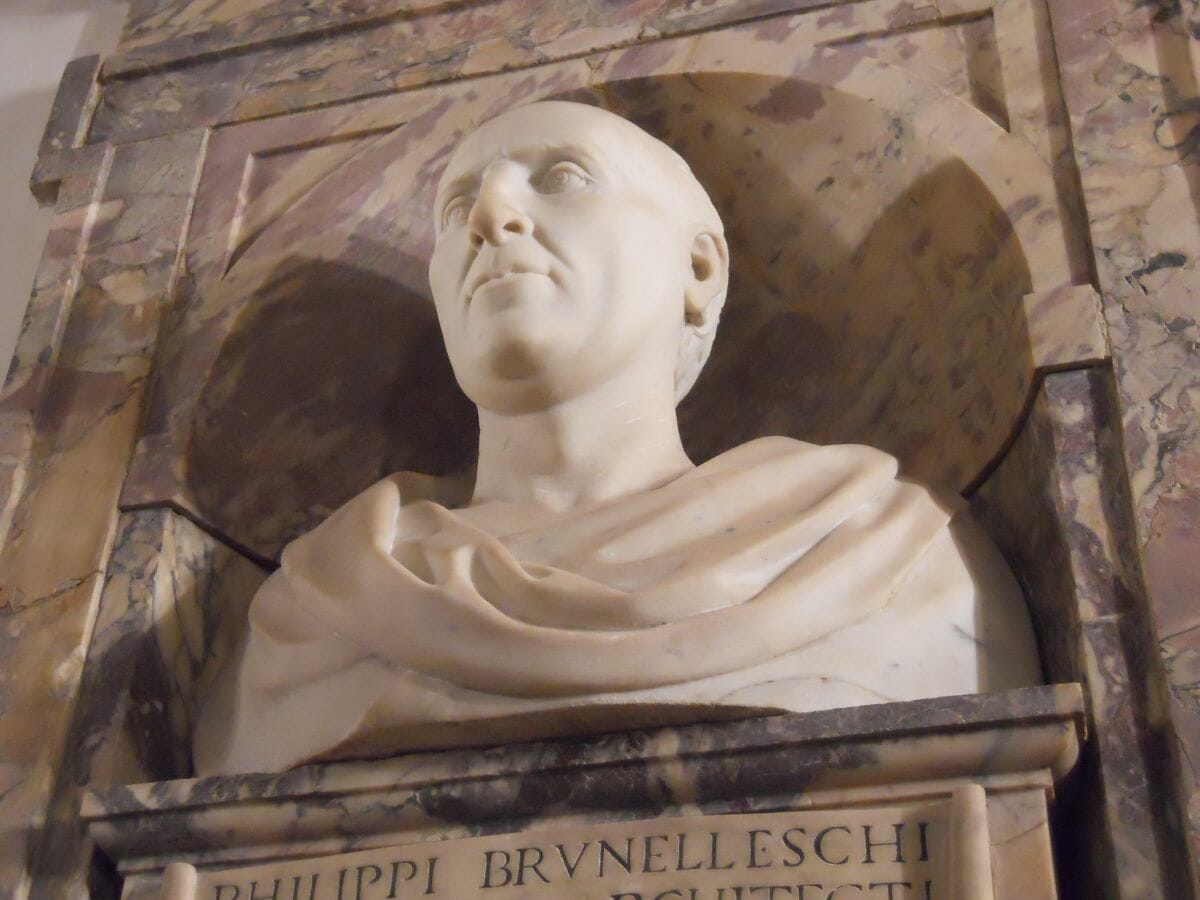
Filippo Brunelleschi’s influence on Florence cannot be understated. Photo credit: Erik Drost
Brunelleschi silenced skeptics using an egg
By 1380, most of the Florence Cathedral was complete, except for the challenging dome. It wasn’t until 1420 that city leaders organized a competition to find an engineer for the task.
Enter Brunelleschi, who boldly claimed he could design the perfect dome but kept his methods secret to avoid competition. He declared he wouldn’t use traditional wooden support, a costly option due to shipping expenses.
This was met with skepticism, but Brunelleschi challenged his critics to prove their own expertise by making an egg stand upright on a flat surface without any assistance. After everyone failed to do so, Brunelleschi took the egg, slightly cracked its bottom to create a flat surface, and easily made it stand upright. He then explained that, just like the egg, his dome could be constructed using a similarly simple and clever method.
Ultimately won the bid with his innovative plan that sparked imagination.
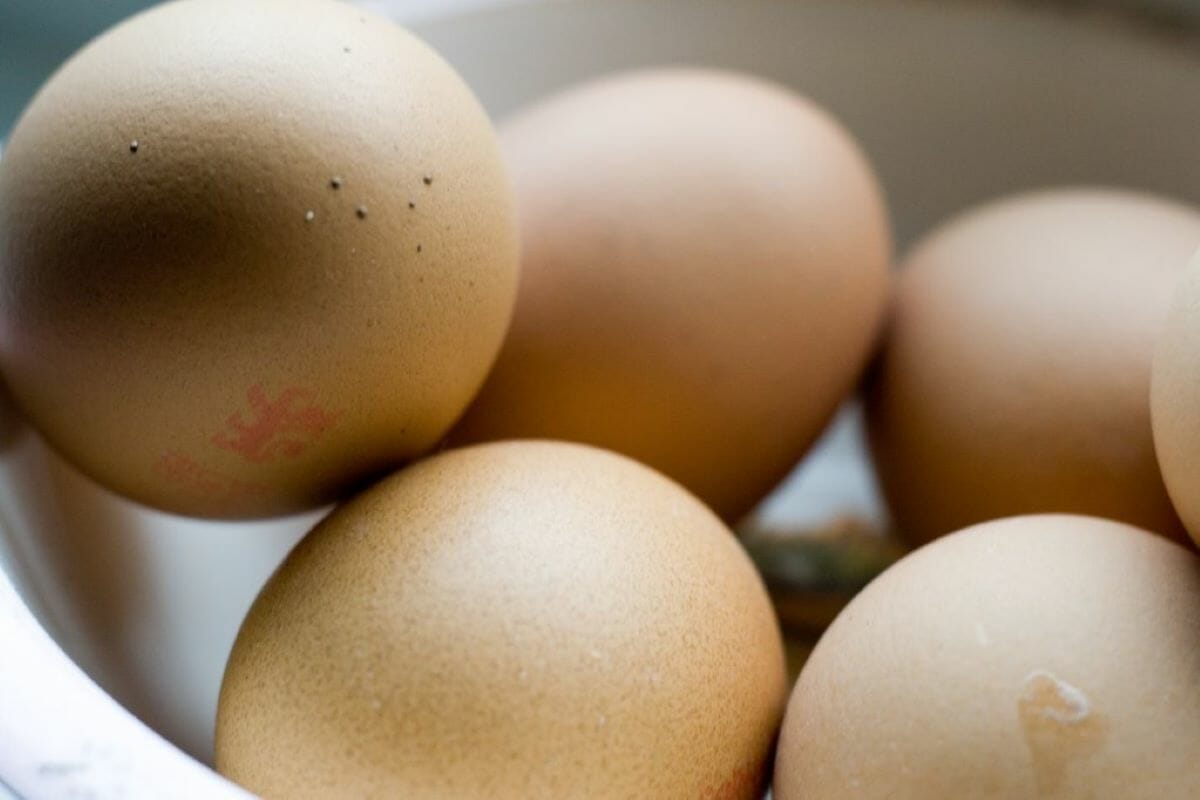
Brunelleschi silenced skeptics using none other than a simple egg—and proved his point. Photo credit: Adam
The administrators forced Brunelleschi and his arch-rival to work on the Florence Duomo together
In 1420 Brunelleschi was officially named the superintendent of the project, but the administrators still didn’t completely trust him. Thus, they assigned Lorenzo Ghiberti, another goldsmith, and Brunelleschi’s arch-rival, to be co-superintendent.
Ghiberti was a popular and well-respected artist around town but his relationship with Brunelleschi had never quite recovered from when he had beaten Brunelleschi for the commission to cast the bronze doors of the Florence Baptistery in 1401.
The overseers saw the inclusion of Ghiberti as the perfect way to keep Brunelleschi in line, but the distrust between the two only created more competition and more secrets.
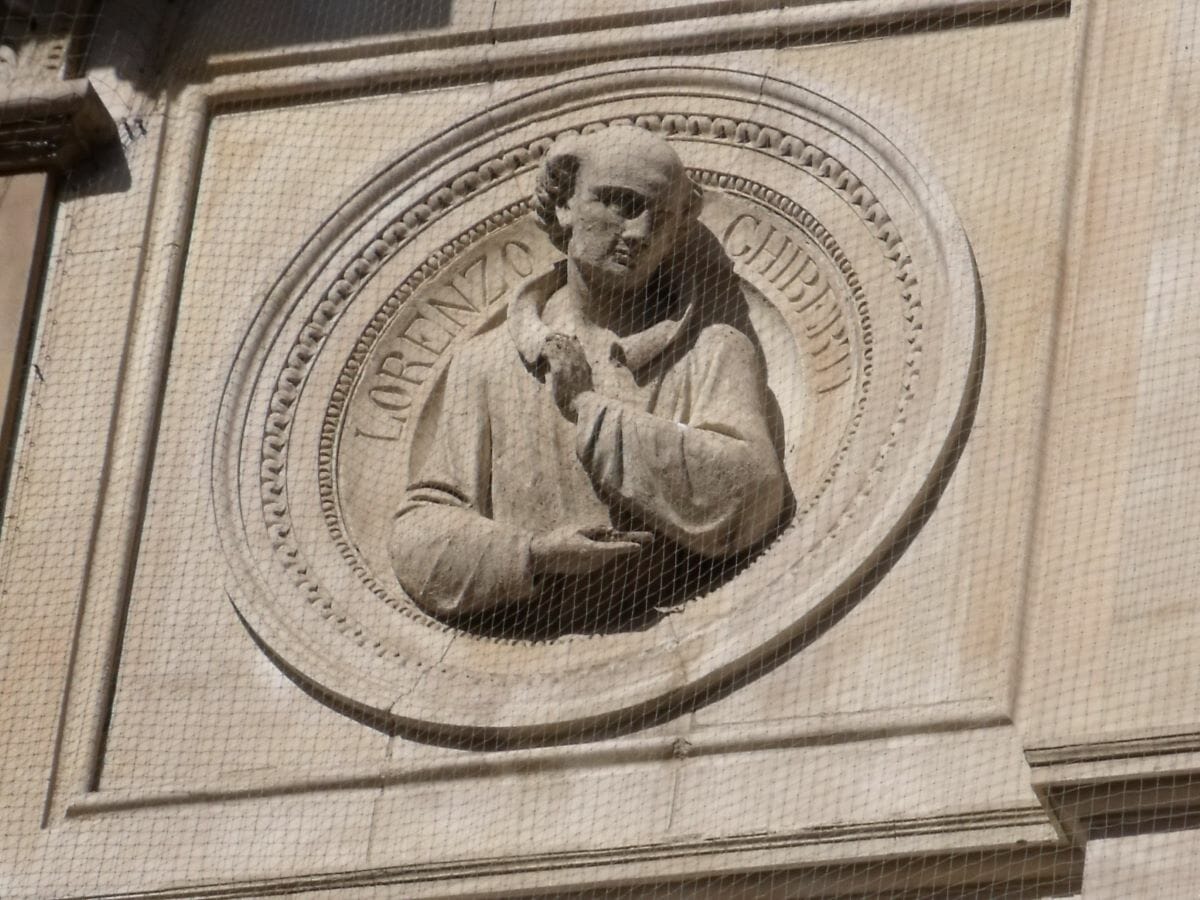
Lorenzo Ghiberti, and Filippo Brunelleschi were arch rivals. Photo credit: Elliott Brown
…And Ghiberti tried to have Brunelleschi thrown in jail
Ghiberti may have instigated officials to jail Brunelleschi in 1434, about 14 years after the start of the Florence Cathedral Dome project, on a technicality.
It seems Brunelleschi was behind on union dues, but that would hardly have been a serious offense for a man of his means. Whatever the case, he was released almost immediately and got the last laugh by watching the Duomo grow nearly one foot per month.
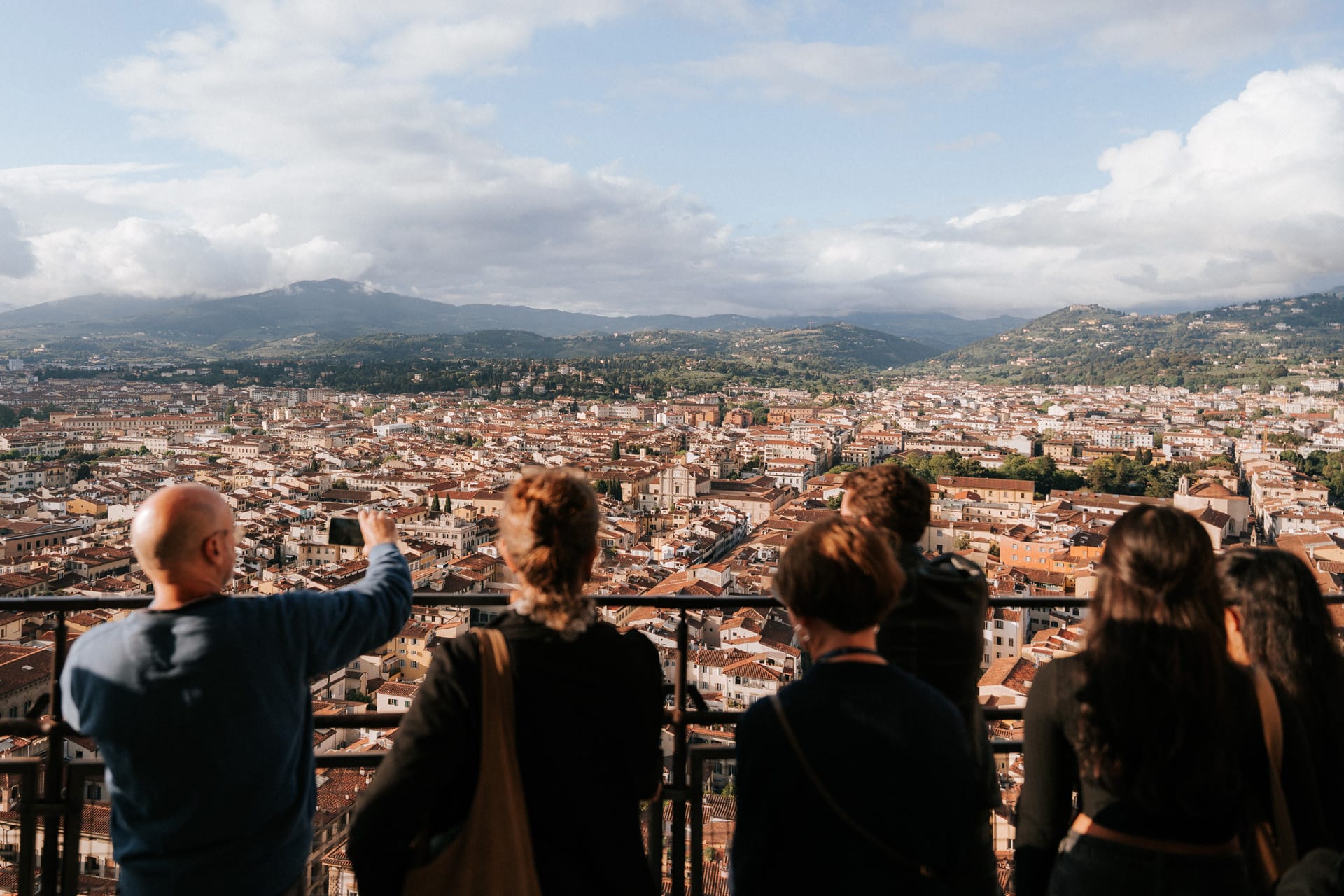
Brunelleschi catapulted the renowned Tuscan dish Peposo to fame
The dome’s construction was a significant event in the city, as the cathedral had an unfinished hole for many years. Thus, Brunelleschi faced immense pressure—but he still found time for side projects and innovations.
One cool invention? To transport materials to the dome’s roof, he invented an ox-powered crane capable of lifting massive stones.
Brunelleschi also had a clever solution for the high demand for bricks during the Florence Cathedral’s dome construction. He built a large furnace in Impruneta, a nearby town known for its Peposo (beef stew). While overseeing the project, he frequented the town and grew fond of the local dish. Brunelleschi liked it so much that he introduced Peposo to Florence and shared it with his workers.
This culinary tradition has since become an iconic part of the city’s cuisine and is a must-try for visitors. This culinary tradition is now a beloved part of the city’s cuisine and is a must-try for visitors (and deserves an honorary mention on your list of what to eat in Florence). Give it a try at one of the best Italian restaurants in Florence!
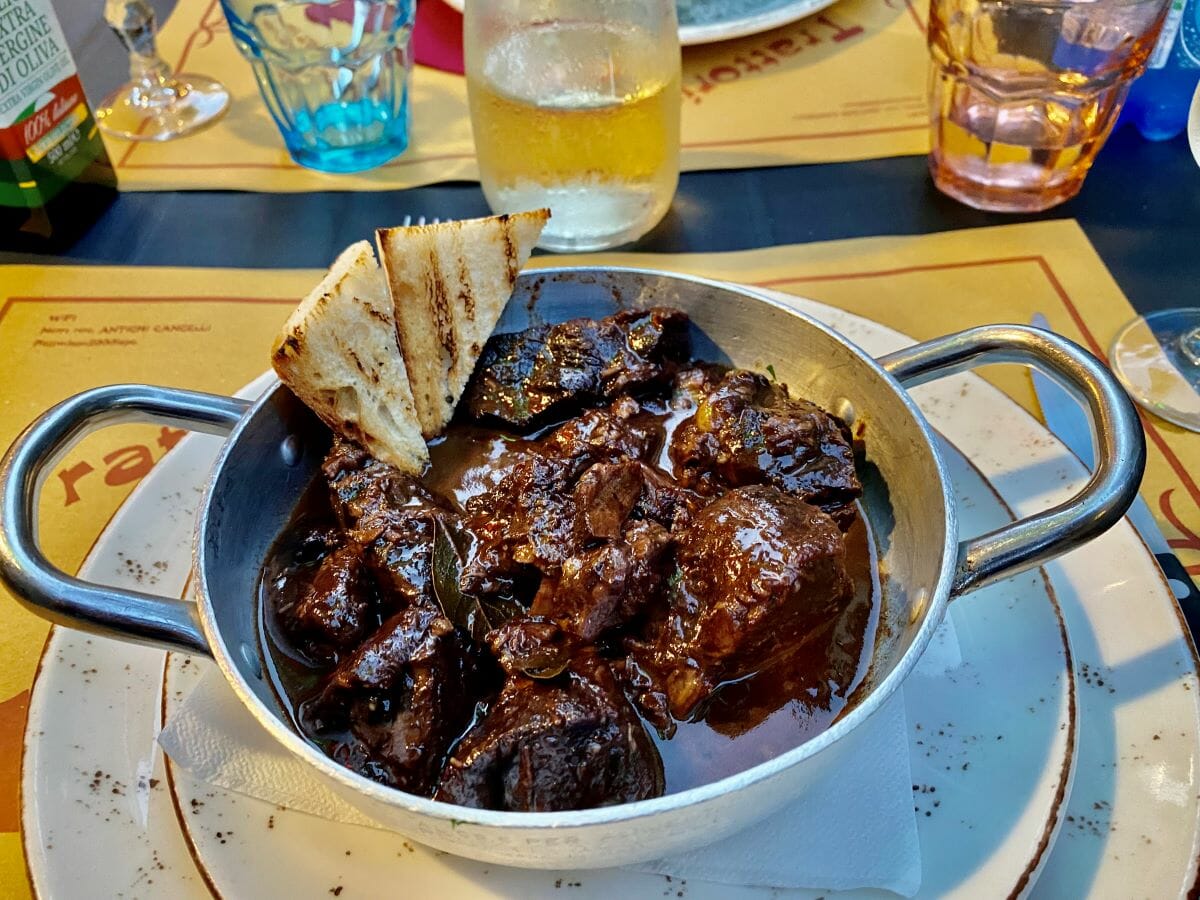
Reposo is made primarily with beef, black pepper, red wine, garlic, and sometimes tomato sauce. Photo credit: Kalboz
Brunelleschi’s dome has survived 600 years
Despite initial doubts, Brunelleschi succeeded in constructing one of Italy’s most enduring landmarks, which has stood the test of time and remains an iconic architectural achievement recognized both in Italy and around the world.
Today, visitors can climb the 463 steps to the top of the dome for panoramic city views.
However, it’s important to note that the Florence Dome climb is not suitable for everyone. The stairs are numerous, small, steep, and narrow and were originally built for workers (not for the millions of tourists that flock to the city annually).
If you prefer not to tackle long hikes, tight spaces, or heights, you might consider visiting the Florence Duomo Museum. This lesser-known gem offers fascinating exhibits on the dome’s construction, original bronze doors from the Baptistery, and a stunning reconstruction of the church’s original facade.
Despite enduring wars, storms, and multiple earthquakes, the dome has required minimal refurbishment. This resilience stands as a testament to Florence’s strength and wealth and serves as an enduring symbol of the city, visible from afar.
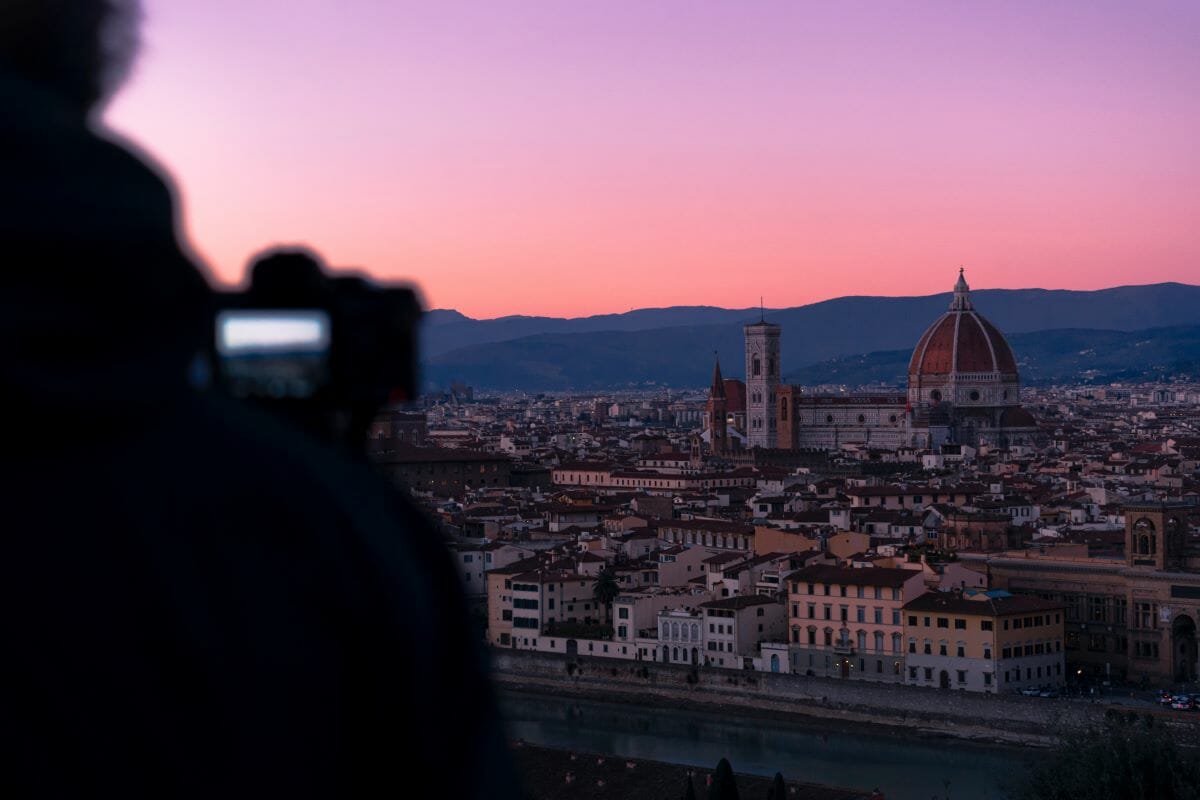
Millions of people flock to the Florene Duomo anually. Photo credit: Samuele Giglio
Taking a Guided Tour of the Duomo:
If you’re eager to truly uncover the secrets and splendor of the Florence Duomo, the Florence David & Duomo Tour with Dome Climb offers an unforgettable, expert-led experience. This guided tour not only includes skip-the-line access to climb Brunelleschi’s dome—arguably one of the greatest architectural feats of the Renaissance—but also grants access to exclusive areas like the Cathedral terraces, which are normally closed to the public. Along the way, your guide will bring the history of Santa Maria del Fiore to life, offering insights into its design, construction, and the fierce rivalries behind its creation. With expert commentary and a panoramic view from the very top, this tour gives you a deeper understanding of the ingenuity behind the Duomo—and a whole new perspective on Florence itself.
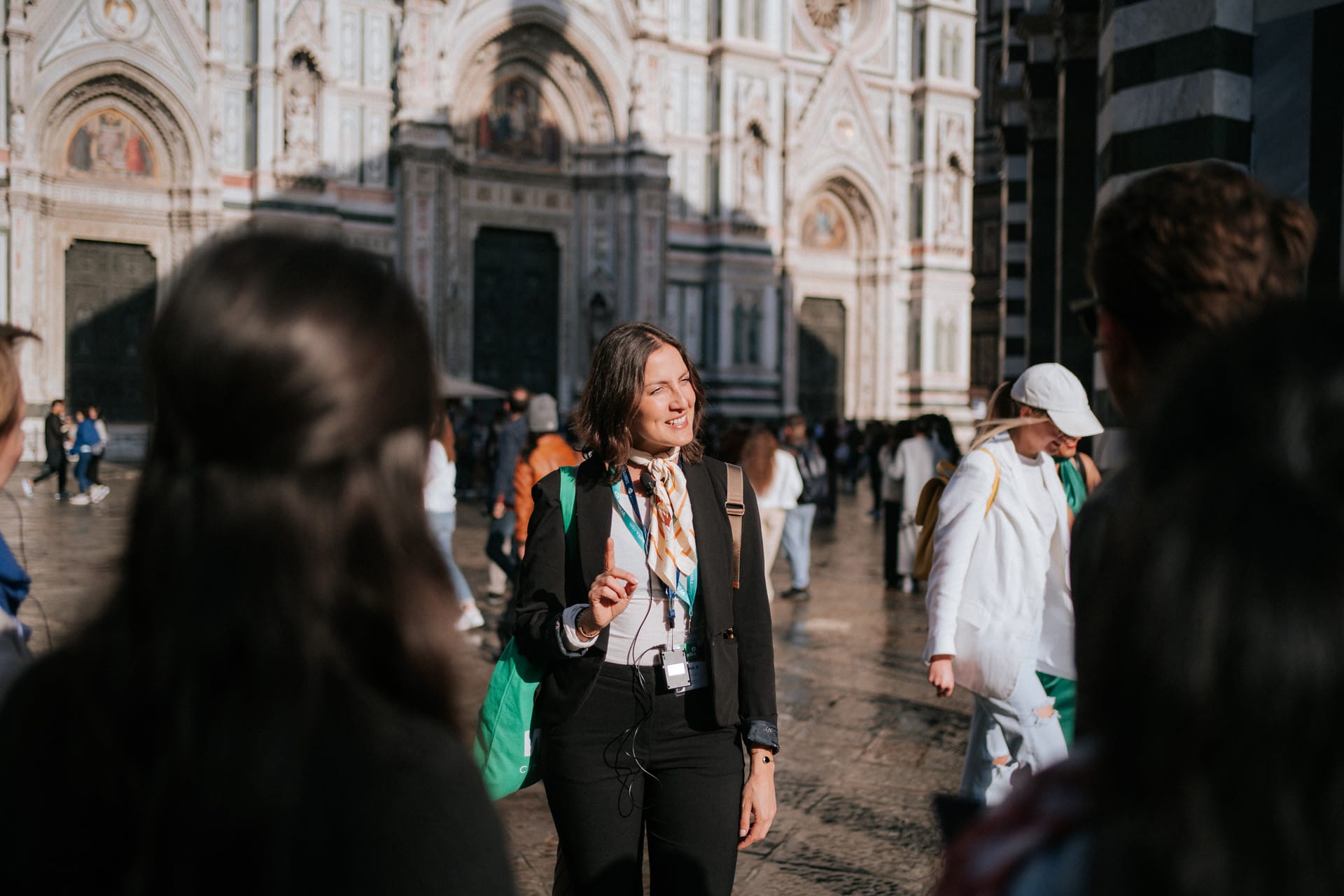
You will learn a lot on a guided tour!
FAQ
Can you climb to the top of the Florence Duomo?
Yes, you can! Visitors can climb 463 steps to reach the top of Brunelleschi’s Dome, where breathtaking panoramic views of Florence await. Just keep in mind that there is no elevator, and the stairways are narrow and steep.
Do I need tickets to enter the Florence Duomo or climb the dome?
Entrance to the main cathedral is free, but tickets are required to climb the dome, visit the bell tower, crypt, baptistery, and the Duomo Museum. Booking tickets in advance is highly recommended, especially during peak season.
Is the dome climb suitable for everyone?
The climb is challenging due to the number of steps, tight spaces, and steep stairways. It’s not recommended for those with claustrophobia, vertigo, heart conditions, or mobility issues.
Update Notice: This post was updated on May 15, 2025.
Want to learn even more fascinating facts about this Italian masterpiece, and Michelangelo’s David? Join us on our VIP David & Duomo Tour: Early Accademia Tour & Skip the Line Dome Climb with Exclusive Terrace Access tour for an incredible, detailed experience led by our team of expert guides.
by Gina Mussio
View more by Gina ›Book a Tour

Pristine Sistine - The Chapel at its Best
€89
1794 reviews

Premium Colosseum Tour with Roman Forum Palatine Hill
€56
850 reviews

Pasta-Making Class: Cook, Dine Drink Wine with a Local Chef
€64
121 reviews

Crypts, Bones Catacombs: Underground Tour of Rome
€69
401 reviews

VIP Doge's Palace Secret Passages Tour
€79
18 reviews

Legendary Venice: St. Mark's Basilica, Terrace Doge's Palace
€69
286 reviews









